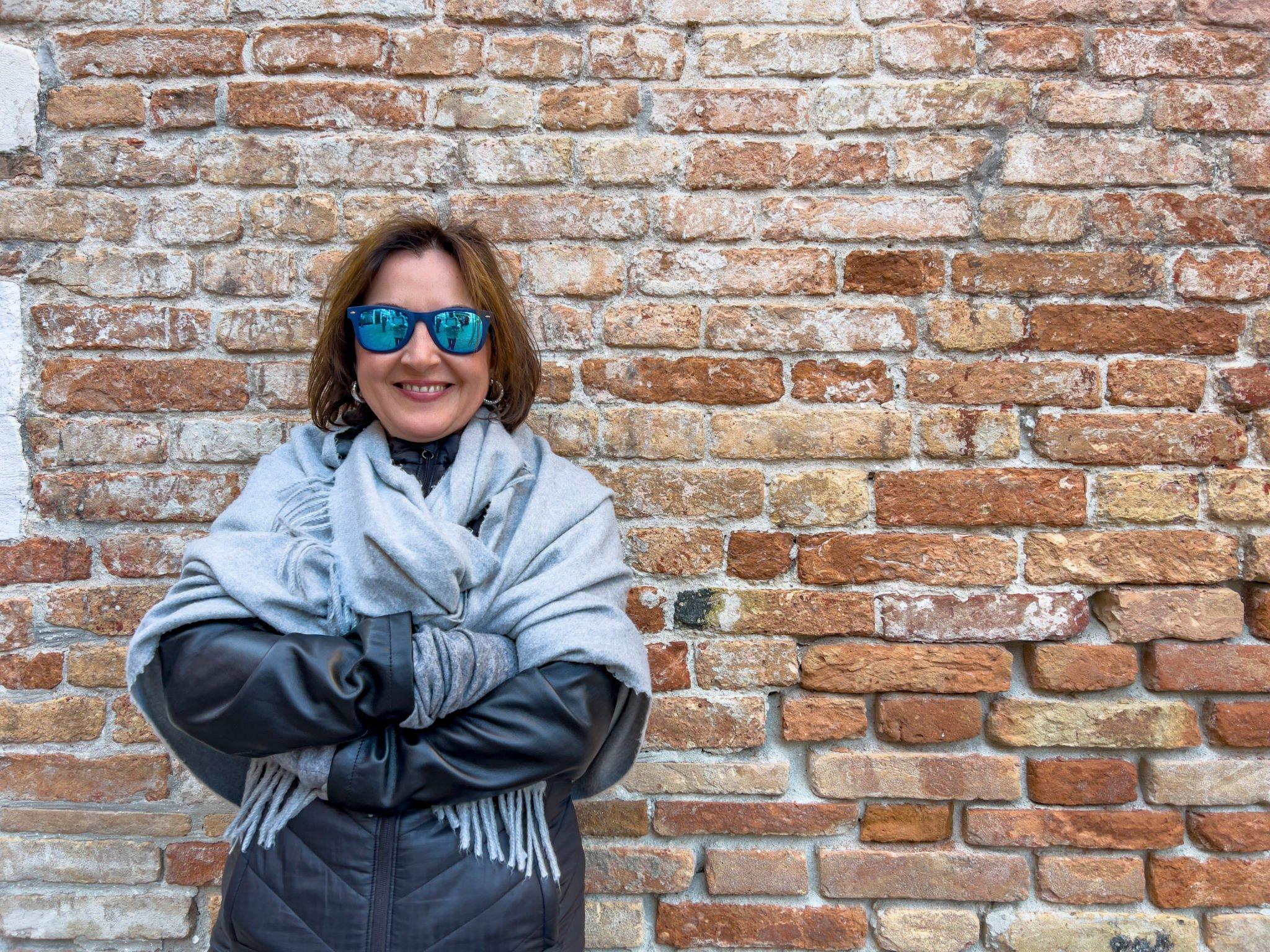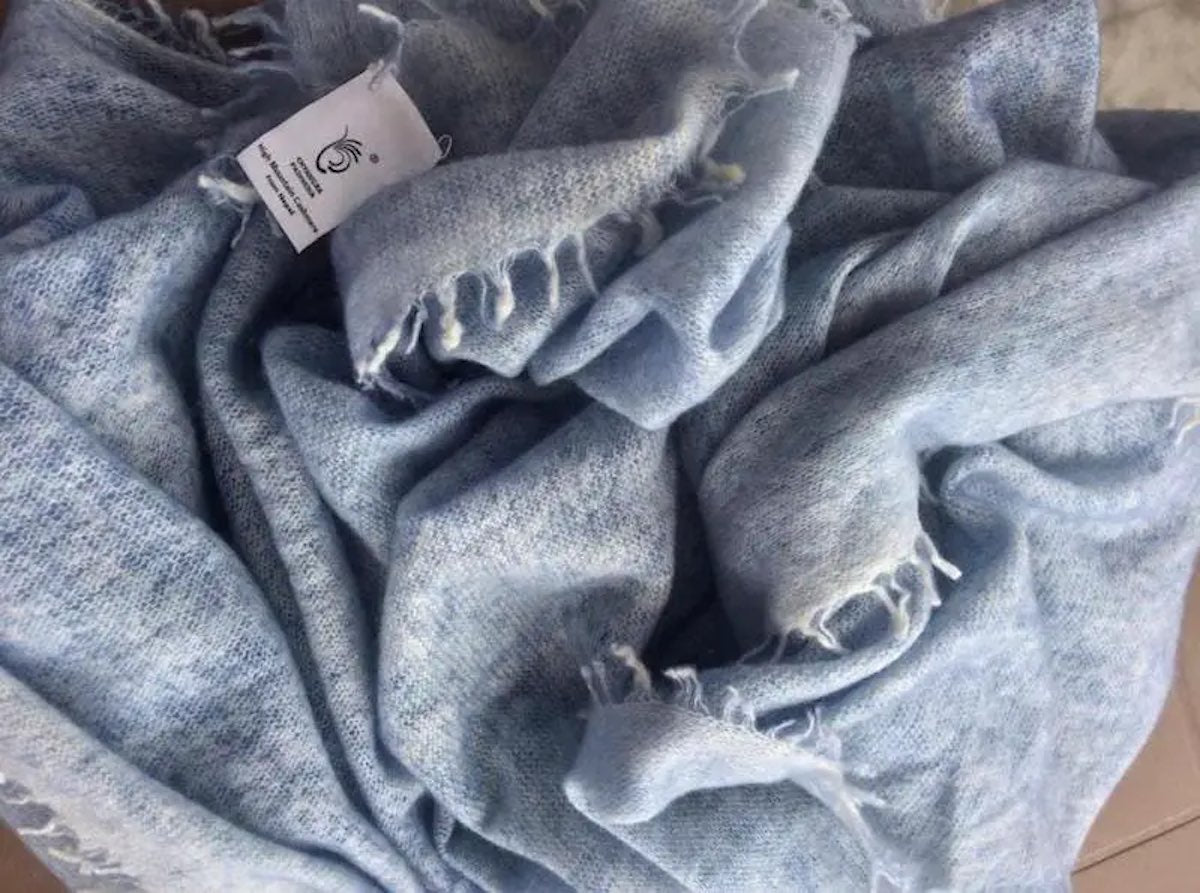The heart of Pashmina production lies in the rugged, remote regions of the Himalayas in Nepal, over elevations of 4500 meters. Once the raw material (the wool from the "Chyangra" goat) reaches bustling cities (usually Kathmandu), things start to get murkier. It becomes a hotbed for unscrupulous sellers to mix in lower quality materials and pass them off as genuine.
The result? An explosion of misleading products that overshadow the craftsmanship and heritage of true Pashmina, and denying buyers like you with the unique and luxurious experience that these textiles offer.
A sea of scarves and shawls parade under the banner of 'Pashmina' or 'Cashmere,' on platforms like Amazon and Etsy today. Masquerading inferior or entirely faux materials for the real deal is everywhere - on social media, in online marketplaces and even big brands (we're not naming any names but we're watching you). Most of these are merely 'Cashwool' - a material blend that's far from the luxurious authenticity of real pashmina.
We want to protect you from falling for such counterfeits. In this article, we'll guide you through the distinguishing characteristics of genuine Pashmina, ways to identify fakes, and the finer details you should be looking for before reaching your pocket.
Let's get started...
1. Texture: Nothing so Soft as Chyangra Pashmina
Pure Pashmina feels incredibly soft, lightweight, and luxurious. Run your fingers along the length of the fabric. It should glide smoothly, almost like a gentle caress, and you should not feel any roughness or coarseness.
Additionally, genuine Pashmina has a unique characteristic related to pilling - the little balls of fluff that often appear on the surface of knitted materials. Authentic Pashmina products do show pilling initially due to the nature of the fiber. However, this subsides with time and use.
In many instances, Pashmina is blended with other natural fibers such as yak or sheep wool to lend more durability while also reducing the luxury and price of the craft. These blends still maintain a high level of softness and quality but can feel slightly heavier than pure Pashmina.
While you may hear about or see a 'Ring Test' - where a Pashmina shawl is pulled through a ring to attest to its fineness - we advise against using it as a measure of authenticity. It's a common myth and has unfortunately been used as a selling tactic by less scrupulous sellers. The ring test doesn't account for variations in weave tightness, ply, or fiber length, and can easily be manipulated.
2. Craftsmanship: Perfection in Imperfection
True Pashmina is a testament to time-honored traditions and skills passed down through generations. While all Pashmina might not be handwoven, many products like shawls, wraps, and sweaters often are.
This is especially true for our Pashmina shawls that come straight from Nepal, where the craft is a significant part of the cultural heritage.
You'll often see a certain level of irregularity in the weave of a genuine Pashmina product, a reflection of its handmade nature. These slight inconsistencies can often be felt as a subtle 'textural rhythm' when you run your hands across the fabric.
The machine-made cashmere fabric has a uniform weave that does not have these natural variations. While this might be appealing or make the products look trendy, this uniformity is a red flag in the world of Pashmina.
The artisanal aspect of Pashmina is part of its charm and value that we treasure at our company Plushmina. All of our shawls are handwoven with 100% pure cashmere Pashmina and reflect the signs of skilled craftsmanship from the Himalayas.
3. Warmth: Feather-light, Yet Toasty
One of the defining characteristics of real Pashmina is its ability to provide significant warmth while being astonishingly lightweight. This is because Pashmina is derived from the undercoat of the Chyangra goats which have adapted to survive the freezing temperatures of the Himalayas at elevations of 4500 meters.
When you wrap our Pashmina shawl around your shoulders, you'll experience a gentle, enveloping warmth. It does not feel heavy or stifling but rather light and comfortably toasty. On the contrary, faux Pashmina or low-quality blends may not offer the same level of warmth and comfort, especially in cold conditions.
This delicate balance of lightness and warmth is part of the Pashmina magic. If a 'Pashmina' product feels unnecessarily heavy or doesn't offer enough warmth, you might want to think twice before making a purchase.
4. Price: A Reflection of Quality and Craftsmanship
Genuine Pashmina holds its position as a premium product and its value lies not just in its inherent luxury, but also in the painstaking process of its creation. Each piece involves rearing the Chyangra goats at high altitudes, the delicate work of hand-harvesting the wool with traditional tools, and the skilled craftsmanship in weaving in hand looms – a true labor of love.
The road to finding an authentic Pashmina at a fair price isn't always straightforward. Some brands exploit the luxury pricing, offering subpar or even counterfeit products at inflated prices. The rule of thumb is, an extremely low-priced 'Pashmina' is likely a counterfeit. On the other hand, an excessively priced Pashmina doesn't guarantee authenticity either.
At Plushmina, we strike a balance between fair pricing and maintaining the superior quality of our Pashmina products. Each of our shawls is priced at $250, reflecting the meticulous process behind its creation and the exceptional quality of the authentic Pashmina used.
We believe in honoring the craftsmanship behind each product while ensuring our customers receive genuine, top-grade Pashmina without an unjustifiable price tag.
So, before you're swayed by a 'great deal' or an overly hefty price tag, consider the value and authenticity of the product you're investing in. True Pashmina is indeed a luxury, but its price should reflect its real worth and not be arbitrarily inflated.
5. Ply and Microns: Don't Let the Technical Terms Fool You
Pashmina is a unique material, characterized not just by its source but also by its thickness, quality, and warmth. The source, the Chyangra goat, produces two types of fiber: the outer, coarser coat, and the inner, softer undercoat. The latter is what gives Pashmina its nickname 'Diamond Fiber.' The coarser coat is removed, leaving only the finest undercoat fibers that are spun into Pashmina.
The thickness of these fibers can vary, but the very best Pashmina - like those used in our products at Plushmina - should not exceed 14-16 microns in diameter. A micron is one millionth of a meter, and to give you an idea of just how fine this is, human hair typically measures between 50-70 microns.
Pashmina also comes in a variety of ply, which refers to how many yarns are twisted together to create the fabric. You may see 2-ply, 3-ply, or even 4-ply Pashmina, with each ply adding to the weight and warmth of the final product.
At Plushmina, we adhere to the highest standards when crafting our Pashmina products. Our Pashmina passes rigorous tests and consistently scores over 97% for purity.
Our standards include:
- Fiber Diameter: The fiber diameter in our products does not exceed 14-16 microns, ensuring the fabric is extremely soft and luxurious.
- Fiber Purity: Our products score more than 97% on purity tests, indicating the high quality of our Pashmina fibers.
- Color Fastness: Our products have high color fastness, meaning the colors will remain vibrant and beautiful even after many uses and washes.
- Dyeing: Your health and safety are our priority. Our Pashmina products are free from harmful AZO dyes. These dyes can have harmful effects, and we ensure their absence from our products.
When you are buying a Plushmina product, you're not just buying a fashion accessory; you're becoming a part of a centuries-old tradition of luxury and craftsmanship in the rugged terrains of the Himalayas.
You're also supporting the communities that produce these beautiful products, ensuring that the art of Pashmina weaving continues to thrive.
By knowing what to look for in Pashmina, you can avoid the many counterfeits in the market and ensure you're getting a genuine product that will bring you joy and warmth for many years to come.
6. Shrinkage
Real Pashmina, if washed carefully in cold water, does not shrink.
However, like all natural fibers, it can shrink when exposed to hot water or a hot dryer. If your Pashmina product shrinks slightly after a wash, it doesn't necessarily mean it's not genuine. Natural fibers do have a tendency to contract slightly when wet.
Lower quality Pashmina often contains a significant amount of synthetic fibers mixed in, which tends to shrink noticeably even in warm water. If the shrinkage is significant, this could be a sign that the item is not pure Pashmina.
As always, real Pashmina requires gentle handling and care - hand washing in cold water with a mild detergent (like a baby shampoo) is recommended.


